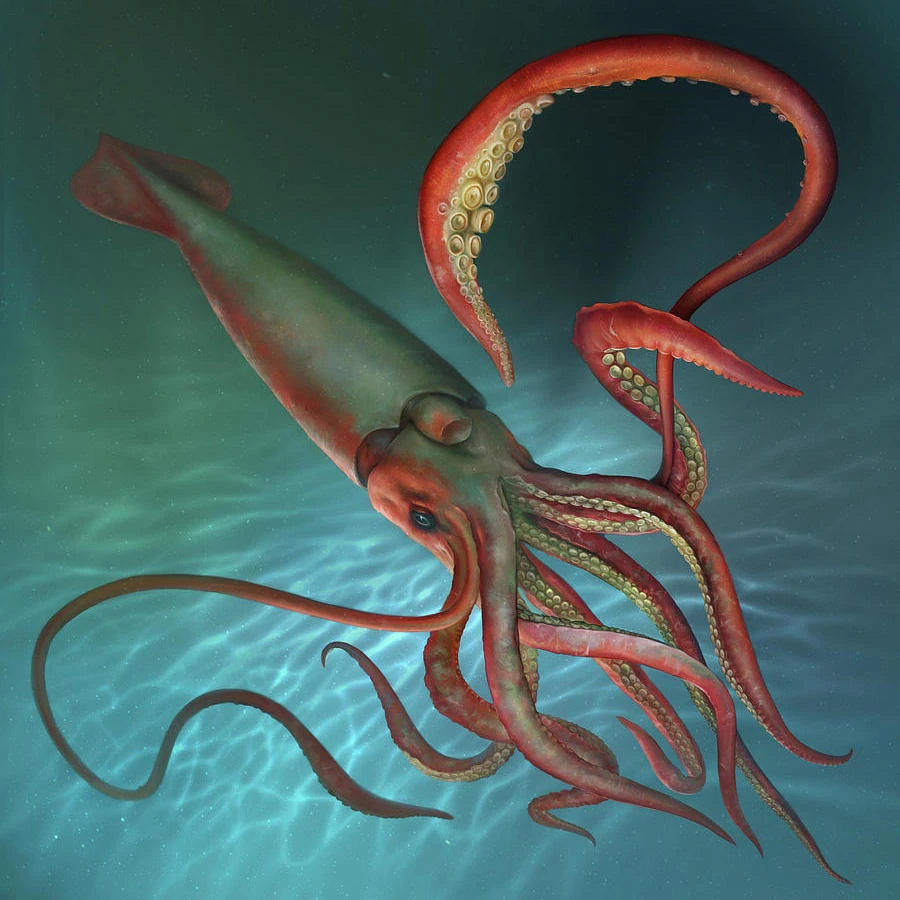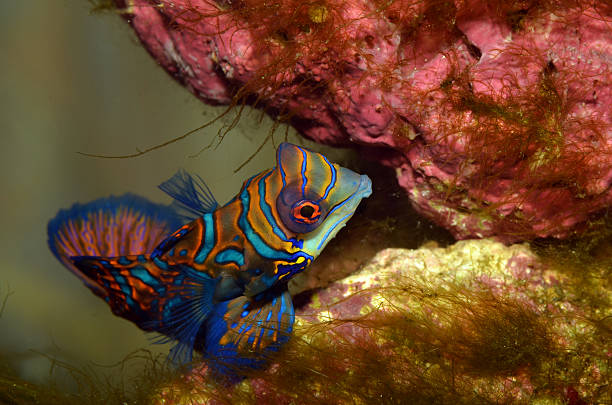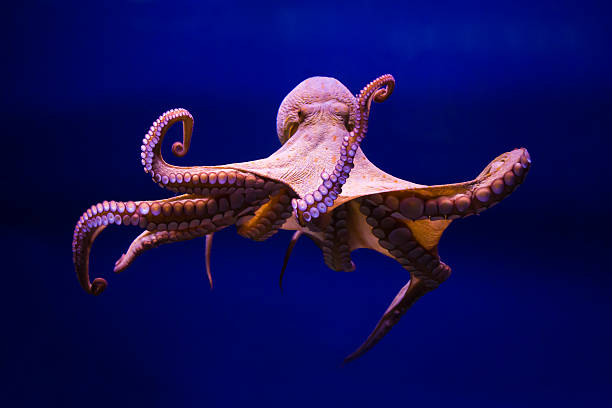For centuries, sailors told stories of enormous tentacled monsters that rose from the depths to drag ships and men into the sea. They called them “krakens,” and though these tales were dismissed as myths for generations, they were rooted in fleeting encounters with a very real and extraordinarily elusive creature: the giant squid. Known to science as Architeuthis dux, this deep-ocean cephalopod is one of the most mysterious animals on Earth—an enormous invertebrate that can grow longer than a bus yet has rarely been seen alive by human eyes.
The giant squid occupies a unique place at the intersection of legend and science. For hundreds of years, it existed only as a shadow in folklore, its body occasionally washing ashore after storms. Modern research has begun to peel away some of the layers of mystery surrounding it, yet much about its behavior, reproduction, and ecology remains unknown. The deep ocean is the largest, least explored habitat on the planet, and the giant squid is one of its most fascinating inhabitants. Understanding this creature is not just about satisfying human curiosity—it also sheds light on the evolution of intelligence, adaptation, and survival in one of Earth’s harshest environments.
A Creature of Legend and Science
The earliest known references to creatures resembling giant squids appear in Norse mythology, where the kraken was described as a colossal sea monster capable of swallowing entire ships. In the 13th-century Icelandic sagas, sailors recounted the “hafgufa,” a monster whose body was mistaken for an island. Across centuries and cultures, similar stories emerged from sailors who claimed to see enormous tentacles rising from the sea, sometimes wrapping around vessels or pulling livestock from the shore.
These myths likely stemmed from the discovery of dead or dying giant squids that washed up on beaches. Their long tentacles, sharp beaks, and enormous eyes must have seemed otherworldly to those who encountered them. Before the 19th century, there was no scientific proof that such creatures existed, and most scholars regarded them as exaggerated fables.
That changed in the mid-1800s, when naturalists began receiving credible reports of large cephalopods found in northern European waters. In 1857, Danish zoologist Japetus Steenstrup formally described the species Architeuthis dux, marking the first scientific recognition of the giant squid. Since then, numerous specimens have been recovered from oceans around the world, confirming that these creatures are not only real but widespread.
Despite this, sightings of live giant squids have remained extremely rare. The first photographs of a live giant squid were not captured until 2004, and the first video footage came in 2012, recorded off Japan’s Ogasawara Islands by a team of researchers from Japan’s National Science Museum. These historic observations revealed a sleek, silver-bodied animal with long, powerful tentacles, propelling itself gracefully through the dark waters of the deep.
Anatomy of a Deep-Sea Giant
The anatomy of the giant squid is both awe-inspiring and highly specialized for survival in the deep ocean. Like all cephalopods—members of a class that includes octopuses, cuttlefish, and other squids—Architeuthis dux possesses a soft body, large eyes, and remarkable control over its limbs and movements. Yet its sheer scale sets it apart.
Adult giant squids can reach lengths of 12 to 13 meters (nearly 43 feet) when the long feeding tentacles are included, although most specimens are smaller. Females are significantly larger than males, a trait known as sexual dimorphism, which is common among cephalopods. The main body, or mantle, measures several meters long and contains most of the animal’s vital organs, including the stomach, liver, and gills.
The squid’s head bears eight shorter arms and two extraordinarily long tentacles, each lined with suckers equipped with serrated chitinous rings. These suction cups create a powerful grip, allowing the squid to capture slippery prey in near-total darkness. When attacking, the squid shoots its tentacles forward to ensnare prey and then reels it in toward the arms, which manipulate and guide the catch to its beak.
At the center of the arms is the squid’s beak—dark, parrot-like, and incredibly strong. Made of chitin, it is one of the hardest biological materials known, capable of slicing through the tough flesh of fish and other squids. Behind the beak lies a rasping organ called the radula, a tongue-like structure covered with tiny teeth that further grinds the food before digestion.
One of the most striking features of Architeuthis dux is its eyes. Each eye can reach up to 27 centimeters (10.6 inches) in diameter—roughly the size of a dinner plate—and is the largest eye of any known animal. These enormous eyes allow the giant squid to detect faint traces of light in the deep ocean, such as the bioluminescent glow of other creatures or the silhouette of a distant predator. In the eternal twilight of the mesopelagic and bathypelagic zones, such vision can mean the difference between life and death.
Life in the Abyss
The deep ocean, where giant squids live, is an environment of extremes. Sunlight fades completely by about 1,000 meters below the surface, and temperatures hover near freezing. The pressure at these depths can exceed 100 times that of sea level, crushing to dust any air-filled structure. Few animals can survive here, but those that do are marvels of adaptation—and the giant squid is among the most remarkable of them all.
Architeuthis dux is believed to inhabit the mesopelagic to bathypelagic zones, roughly between 300 and 1,000 meters deep, though it may occasionally descend even deeper. Because humans rarely explore these depths directly, much of what we know about its habitat comes from indirect evidence, such as where dead squids have been found or where sperm whales—its main predators—hunt.
Unlike some cephalopods that live on the seafloor, the giant squid is a pelagic species, drifting and swimming in open water. It moves primarily by jet propulsion, expelling water from a muscular siphon beneath its head. This method allows for bursts of rapid movement, although it is energy-intensive. Giant squids also possess fins near the rear of the mantle, which they use for gentle, sustained motion when not hunting or evading predators.
The squid’s physiology is uniquely suited to the cold, high-pressure conditions of the deep. Its blood contains a copper-based molecule called hemocyanin, which transports oxygen more efficiently than hemoglobin at low temperatures. Its body is soft and flexible, without internal bones, allowing it to withstand immense pressure without collapsing.
Despite its size and power, the giant squid remains elusive and ghost-like in its environment. Its movements are slow and deliberate most of the time, conserving energy in the nutrient-poor deep sea. It likely rises and descends with oceanic currents, following prey that migrate vertically between the dark depths and the upper layers of the sea.
Hunting and Diet
The giant squid is a formidable predator, though it lives in near-total darkness. Scientists believe it hunts primarily by using its large eyes to detect the faint bioluminescence of smaller creatures or the shadows they cast against any available light. It also may use chemical cues in the water to locate prey.
Its diet consists mainly of deep-sea fish, smaller squids, and possibly crustaceans. Using its long tentacles, it captures prey with lightning speed, pulling it toward the beak and using its radula to shred it into manageable pieces. In some cases, evidence from stomach contents and scars on other squids suggest that giant squids may also engage in cannibalism.
One of the most fascinating aspects of the giant squid’s ecology is its relationship with the sperm whale. The two are locked in one of nature’s most dramatic predator-prey relationships. Sperm whales dive thousands of meters in search of squid, their favorite food, and their stomachs often contain the indigestible beaks of Architeuthis dux.
Many sperm whales bear circular scars on their heads and bodies—marks left by the giant squid’s powerful suckers during desperate struggles in the deep. Though the whale nearly always wins, the existence of these scars offers vivid proof of the battles that unfold in the black depths of the ocean, far beyond human sight.
Reproduction and Life Cycle
Very little is known about how giant squids reproduce or how long they live. Most of what we understand comes from dissected specimens and comparisons with smaller, related squid species. Like other cephalopods, the giant squid reproduces sexually, with males transferring packets of sperm, called spermatophores, to the female using a specialized arm known as the hectocotylus.
However, the exact process remains mysterious. Some evidence suggests that males may inject spermatophores directly into the female’s mantle tissue, where they later fertilize eggs. Females produce tens of thousands of eggs, each only a few millimeters in diameter. It is thought that the eggs are released into the water column, where they develop and hatch into small, free-swimming larvae.
These juvenile squids likely inhabit shallower waters at first, feeding on plankton and small fish, before migrating to deeper regions as they mature. Growth in squids is rapid, and giant squids may reach their enormous size in only a few years. Like many cephalopods, they probably have short lifespans, perhaps only five to ten years, though this remains uncertain.
The life cycle of the giant squid underscores the transient and fragile nature of existence in the deep sea. Few offspring survive to adulthood, and those that do must evade predators and compete for scarce food in an environment that offers no shelter or refuge.
The Role of Giant Squids in the Ecosystem
Although they are rarely seen, giant squids play a crucial role in the deep-ocean food web. As predators, they help regulate populations of midwater fish and smaller cephalopods. As prey, they provide an essential food source for sperm whales and other large marine animals.
Their bodies, when they die and sink to the seafloor, become important sources of nutrients for deep-sea scavengers. In this way, the giant squid contributes to the recycling of organic matter in ocean ecosystems.
Studying the giant squid also provides insights into the broader health of deep-sea environments. Changes in the distribution or abundance of these squids could reflect shifts in ocean temperature, oxygen levels, or prey availability—all indicators of climate change and human impact on the marine world.
Adaptations for Survival
The survival of the giant squid in one of the most extreme habitats on Earth is a testament to evolution’s creativity. Its soft, gelatinous body, enormous eyes, and sophisticated nervous system are all adaptations that allow it to thrive where few others can.
Unlike many deep-sea animals that produce their own bioluminescence, the giant squid relies on detecting light from others, a strategy that suits its role as a predator. Its enormous eyes maximize photon capture, allowing it to spot even the faint glow of bioluminescent prey or the silhouette of a distant sperm whale.
Its muscles are adapted for sudden bursts of speed rather than long endurance, and its tentacles can extend rapidly with hydraulic precision. This combination of stealth and explosive movement makes the giant squid an efficient ambush hunter.
Perhaps most intriguing is the squid’s nervous system. While not as complex as that of an octopus, it is still advanced compared to most invertebrates. Squids exhibit a high degree of neural coordination, controlling their arms, color changes, and movements with remarkable precision. Although no one has observed a live giant squid displaying chromatophore-based color changes, it is likely that it can alter its skin pigmentation as other squids do—perhaps for camouflage, communication, or intimidation.
Scientific Study and Discoveries
For much of human history, knowledge of the giant squid came only from dead specimens washed ashore or retrieved from whale stomachs. These remains offered limited insight into how the animal lived. The challenge of studying giant squids is immense—they inhabit vast, dark regions of the ocean that are difficult and expensive to explore.
The development of deep-sea submersibles, remotely operated vehicles (ROVs), and advanced cameras has revolutionized marine biology, finally allowing scientists to observe the giant squid in its natural habitat. In 2012, a Japanese research team led by Tsunemi Kubodera and Steve O’Shea captured the first video footage of a live giant squid in the wild. The squid, estimated at around 3 meters long excluding tentacles, was filmed in the Pacific Ocean at a depth of about 630 meters. The footage revealed a sleek, silver-gold creature moving with grace and deliberation—a living being rather than a monster of myth.
Subsequent encounters have provided further glimpses into its behavior. The giant squid appears to be a solitary animal, rarely seen in groups. It may spend much of its time suspended motionless in the water column, waiting for prey. Some evidence suggests that it can exhibit bursts of activity when hunting or threatened.
The ongoing challenge is to study these creatures without harming them or disturbing their environment. New technologies, including low-light cameras, environmental DNA sampling, and autonomous deep-sea drones, offer promising tools for future discoveries.
The Connection Between Giant and Colossal Squids
While the giant squid is impressive, it is not the largest squid known to science. That title belongs to the colossal squid (Mesonychoteuthis hamiltoni), found in Antarctic waters. Though shorter in length due to proportionally smaller tentacles, the colossal squid is much heavier and more robust, with a body mass that can exceed 500 kilograms.
The colossal squid also differs anatomically—it has rotating hooks on its tentacles instead of suckers and eyes that may be even larger than those of Architeuthis dux. These two species represent divergent evolutionary strategies for surviving in the deep ocean: the giant squid as a long, slender predator of temperate waters, and the colossal squid as a massive ambusher of the cold Antarctic depths.
Comparative studies of these two giants are helping scientists understand how cephalopods evolved to dominate nearly every marine habitat, from shallow reefs to the abyssal plains.
Conservation and Human Impact
While the deep ocean may seem remote and untouched, it is increasingly affected by human activities. Climate change, pollution, and deep-sea fishing are altering marine ecosystems in ways we are only beginning to understand. The giant squid’s range and behavior could be influenced by changes in ocean temperature, oxygen content, and prey availability.
Because giant squids are rarely observed, it is difficult to assess their population status. However, like many deep-sea species, they may be vulnerable to shifts in environmental conditions. Monitoring these creatures could therefore provide valuable insights into the health of ocean ecosystems as a whole.
Responsible exploration and conservation of the deep sea are essential, not only to protect iconic species like the giant squid but also to preserve the vast biodiversity that remains hidden beneath the waves.
The Enduring Mystery
Despite all we have learned, the giant squid remains one of nature’s greatest enigmas. We still do not fully understand its migration patterns, its reproductive habits, or its precise role in the deep-sea ecosystem. It is a reminder that even in an age of satellites and supercomputers, our planet still holds immense secrets.
For scientists, the giant squid represents both a challenge and an inspiration. Every new discovery—each photograph, each specimen, each DNA sample—adds another piece to the puzzle, yet the full picture remains incomplete. For the rest of humanity, the squid continues to capture the imagination, a living link between ancient myths and modern science.
Conclusion
The giant squid is more than just a biological marvel—it is a symbol of the ocean’s enduring mystery. It embodies the tension between what we know and what lies beyond our reach, between myth and reality. Its life unfolds in darkness, in waters so deep that light and sound fade to silence, yet its existence connects us to the oldest stories ever told about the sea.
As research continues, we are slowly revealing the truth behind the legend. The giant squid is not a monster but a masterpiece of evolution—an intelligent, adaptive, and essential part of Earth’s biosphere. In its vast, alien world beneath the waves, it continues to glide silently, unseen by most, a reminder that our planet still holds wonders as strange and magnificent as any imagined in myth.
Even today, as science pushes deeper into the ocean’s unexplored realms, the giant squid remains a symbol of mystery—a living testament to the idea that some secrets of nature will always resist complete discovery, inviting us to keep looking into the depths with curiosity, respect, and awe.






